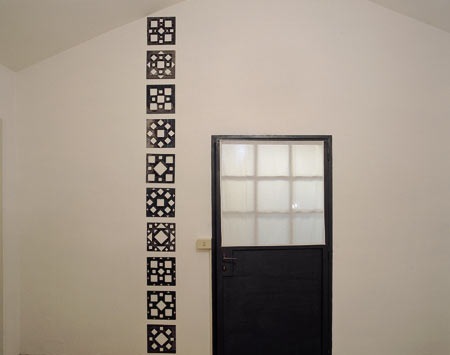![]()
2 |
|

 The Moment
The Moment
10 elements of lead
25 x 25 cm each
Nel momento
10 elementi in piombo
25 x 25 (cad.)
![]()
 Exhibitions
(selection)
Exhibitions
(selection)
1982 Venice Biennial (also in 1986 and 1993)
1982 Documenta VII, Kassel and 1992 Documenta IX, Kassel
1997 Arte italiana 1945-1995, Museum of Contemporary Art, Tokyo, and other
musea
1997 Solo exhibition, Centro per l’arte contemporanea Luigi Pecci,
Prato
1999
Galleria Christian Stein, Milano
2000 Works on paper from Degas to…, Kunstmuseum Winterthur, Winterthur
2001 Watou Poeziezomer, Watou
2002 Solo exhibition, Corinne Hoffman Gallery in Berlin
2002 Continuità, Arte in Toscana 1968-89, Palazzo Fabroni, Pistoia
2003 Palazzo Chigi, San Quirico d’Orcia, Siena
2003 Happiness: A Survival Guide for Art and Life, Mori Art Museum, Tokyo
![]()
The
cycle of works, Nel momento, is heir to the stylistic and thematic
elements evident in works such as Disegno di luce, 1974, and
Ordine familiare del tempo of the same period. In a highly structured
plan of a formal simplicity, the works in this latest cycle state a preference
for light, a dialectic relationship between light and dark, hallmarks
of Salvadori’s work.
“If I remember rightly” he writes, “at the time, I simply kept folding and cutting the lead, until it was almost impossible to fold and cut any more. (...) There can be no more than a certain amount of cutting, and no more than a certain amount of folding. (...) It is like an extension, like creating a dictionary where you keep increasing the words. In short, you increase the words that circumstances allow you to increase.”
His works demonstrate a perfectly balanced composition, despite the resolute strength that they enclose. The material is gently folded by the artist ready to channel new forms of light, to present itself and its context in a new way. “Working with lead brought to memory of drawings done with lead point in the 1500s – I was entranced by its relationship to white, the white space was very obvious compared to the dark areas, which of course, bore the density of the mineral; I was aware of this from the beginning.”
The material is highlighted, the artist’s contribution emphasises its infinite potential, all his work is pure style of form and content. “The rythmic circular motion of the cuts and folds transforms the surface, the sheet of lead. The areas of light and dark vibrate from the direct intervention that communicates an instant and presents itself to the observer and his waking conscience.”(Remo Salvadori)
Remo Salvadori was born in Cerreto Guidi, Tuscany,1947.He lives and works in Milan.



I ciclo di lavori Nel momento, erede di quella linea stilistica e tematica rintracciabile in lavori come Disegno di luce, del 1974 e il coevo Ordine familiare del tempo, attraverso un articolatissimo percorso di semplicità formale denunciano la loro inclinazione alla luce, al rapporto dialettico tra il pieno e il vuoto, caratteristiche denotative del lavoro di Salvadori.
“Allora ho agito semplicemente - scrive l’artista - se ben mi ricordo, piegando il piombo e tagliandolo fino quasi a esaurire le sue possibilità di piegatura e di taglio. (…) Più di una quantità di taglio non ci può essere, più di una quantità di piegatura non ci può essere. (…) è come un ampliamento, è come la costruzione di un vocabolario in cui ti trovi ad aumentare le parole. Insomma aumenti le parole che le circostanze ti mettono nella condizione di aumentare.”
Il suo è un lavoro dalla sintassi perfettamente equilibrata, nonostante la forza propositiva che i lavori racchiudono. La materia è piegata docile dall’intervento dell’artista, pronta a veicolare nuovi moduli di luce, a connotare in maniera nuova se stessa e lo spazio circostante:“nel piombo sentivo il ricordo di certi disegni del Cinquecento eseguiti con punte di piombo, ero catturato dal suo rapporto con il bianco, ciò che veniva vuoto era molto evidente rispetto a ciò che era scuro, che appunto era la densità del minerale; fin dall’inizio vi è stata questa consapevolezza.”
La materia è esaltata, l’intervento dell’artista ne sottolinea le sue infinite potenzialità, il suo lavoro intero è stile purissimo di forma e contenuti. “La circolarità ritmica dei tagli e piegature trasforma il supporto, il foglio di piombo. Vibrano i pieni e i vuoti per l’azione diretta che ci parla del momento e si offre all’osservatore e alla sua coscienza di veglia.” (Remo Salvadori)
Remo Salvadori è nato a Cerreto Guidi, in Toscana, nel 1947 Vive e lavora a Milano

